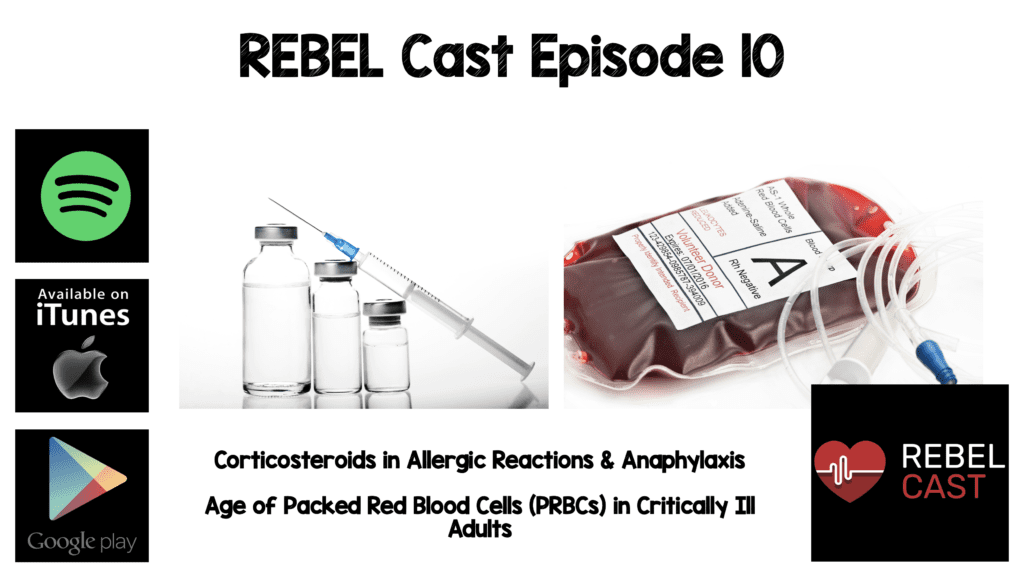 Welcome to the May 2015 REBELCast, where Swami, Matt, and I are going to tackle a couple of articles just published this year. First, there is a lack of research examining the efficacy of steroids in patients with allergic reactions or anaphylaxis. Despite this, corticosteroids are standard care for patients with these disorders. Second, current regulations permit storage of PRBCs for up to 42 days, but maybe fresh PRBCs may improve outcomes in the critically ill by enhancing oxygen delivery while minimizing toxic effects from cellular changes and accumulation of bioactive materials in blood components during prolonged storage. So with that introduction today we are going to specifically tackle:
Welcome to the May 2015 REBELCast, where Swami, Matt, and I are going to tackle a couple of articles just published this year. First, there is a lack of research examining the efficacy of steroids in patients with allergic reactions or anaphylaxis. Despite this, corticosteroids are standard care for patients with these disorders. Second, current regulations permit storage of PRBCs for up to 42 days, but maybe fresh PRBCs may improve outcomes in the critically ill by enhancing oxygen delivery while minimizing toxic effects from cellular changes and accumulation of bioactive materials in blood components during prolonged storage. So with that introduction today we are going to specifically tackle:
- Topic #1: Corticosteroids in Allergic Reactions & Anaphylaxis
- Topic #2: Age of Packed Red Blood Cells (PRBCs) in Critically Ill Adults
REBEL Cast Episode 10: Corticosteroids in Allergic Reactions/Anaphylaxis & Age of PRBCs in Critically Ill Adults
Click here for Direct Download of Podcast
Topic #1: Corticosteroids in Allergic Reactions & Anaphylaxis
Question: Does the addition of corticosteroids in the treatment of allergic reactions and anaphylaxis decrease the likelihood of relapse after emergency department (ED) discharge?
What Specific Article Will We Be Covering?
Grunau BE et al. Emergency Department Corticosteroid Use for Allergy or Anaphylaxis is Not Associated with Decreased Relapses. Ann Emerg Med 2015. PMID: 25820033
Details of the Study
- Background: There is a lack of research examining the efficacy of steroids in patients with allergic reactions or anaphylaxis. Despite this, corticosteroids are standard care for patients with these disorders.
- Study Type: Retrospective Cohort Study at 2 Urban Academic Teaching Hospitals in Canada
- Population: 2701 Allergic Reactions (473 Anaphylaxis)
- Intervention: Corticosteroids Treatment
- Control: No Corticosteroids Treatment
- Outcome: Number of subsequent allergy-related ED visits within 7 days (a “relapse”) in steroid and non-steroid exposed groups
Findings
- Allergy related ED visits were 5.8% vs 6.7% in the steroid and non-steroid exposed groups, respectively
- NNT to prevent one ED revisit is 176 (95% CI NNT 76 – Infinity)
- Anaphylaxis related ED visits were 4.3% vs 5.6% in the steroid and non-steroid exposed groups respectively
- Allergic Reaction related ED visits were 6.4% vs 6.8% in the steroid and non-steroid exposed groups respectively
- 1 vs 4(0.071% vs 0.31%) clinically important biphasic reactions were seen without and with steroids
- 0 deaths in this study
Limitations
- Retrospective chart review, which means missing variables, could cause misclassification of allergic reaction and anaphylaxis
- Patients in the steroid group were sicker at baseline. More of the steroid group patients had respiratory findings, received epinephrine and were diagnosed with anaphylaxis
- No confirmation that steroids were filled at discharge
- Clinically important biphasic reactions could be missed in patients who presented to emergency departments outside of the region
- Due to low rate of anaphylaxis, the adjusted odds ratios may be unreliable
- Adverse events from steroids were not quantified in this study (i.e. harms of steroids)
What is the clinical bottom line for the above clinical question?
Among ED patients with allergic reactions or anaphylaxis corticosteroid use was not associated with a decrease in biphasic allergic responses at 7 days. However, a significant difference in baseline characteristics of the patients limits the application of these results to patients with anaphylaxis.
Topic #2: Age of Packed Red Blood Cells (PRBCs) in Critically Ill Adults
Question: Does the age of PRBCs transfused in critically ill adults affect morbidity/mortality?
What Specific Article Will We Be Covering?
Lacroix J et al. Age of Transfused Blood in Critically Ill Adults. NEJM 2015; 372 (15): 1410-8. PMID: 25853745
Details of the Study
Background: Current regulations permit storage of PRBCs for up to 42 days, but maybe fresh PRBCs may improve outcomes in the critically ill by enhancing oxygen delivery while minimizing toxic effects from cellular changes and accumulation of bioactive materials in blood components during prolonged storage. Blood transfusion services typically provide the oldest compatible blood as an inventory management approach (“1stin, 1stout”) to minimize waste of blood components.
- Study Type: Multicenter, Randomized, Blinded Trial (64 Centers in Canada and Europe)
- Population: Critically Ill patients from tertiary care intensive care units (ICUs)
- Intervention: Transfusion of PRBCs stored for < 8 days (Fresh Blood Group)
- Control: Transfusion of the oldest compatible PRBCs available (Standard Blood Group)
- Outcome: 90 day mortality
Findings:
- Fresh Blood Group stored for mean of 6.1 +/- 4.9 days vs Standard Blood Group stored for mean of 22.0 +/- 8.4 days (p <0.001)
- 90 day mortality: 37.0% (Fresh Blood Group) vs 35.3% (Standard Blood Group) [Not statistically significant]
Limitations:
- Centers using only leuko-reduced PRBCs were used. Whether leukocytes worsen degradation of RBC’s during storage or have other toxic effects that are enhanced by prolonged storage is unknown
- Only PRBCs stored in Saline-Adenine-Glucose-Mannitol (SAGM) were used which is standard PRBC additive solution used in Canada and Europe.In the US PRBCs are typically suspended in Additive Solution-3 (AS-3).
- The issue of harm from PRBCs stored for prolonged periods of time (35 – 42 days) was not assessed in this study
Discussion
- This was a large multicenter trial which allowd the ability to detect clinically important differences in 90 day mortality
- Randomization was concealed
- There was a < 5% rate of loss to follow up
What is the clinical bottom line for the above clinical question?
Among critically ill adult patients the transfusion of fresh (<8 days) PRBCs vs standard issue PRBCs did not affect 90 day mortality



